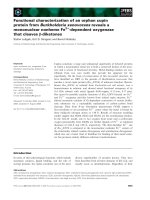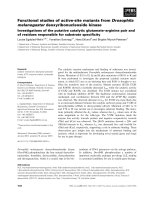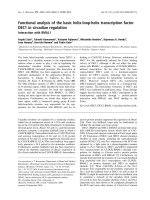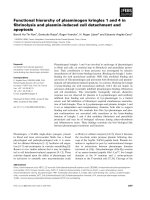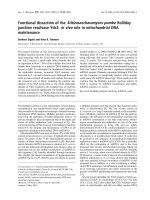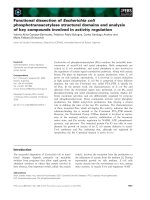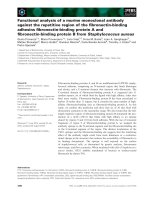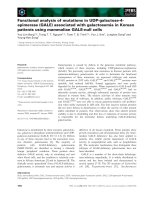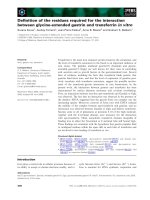Báo cáo khoa học: Functional site of endogenous phospholipase A2 inhibitor from python serum Phospholipase A2 binding and anti-in¯ammatory activity ppt
Bạn đang xem bản rút gọn của tài liệu. Xem và tải ngay bản đầy đủ của tài liệu tại đây (381.34 KB, 9 trang )
Functional site of endogenous phospholipase A
2
inhibitor
from python serum
Phospholipase A
2
binding and anti-in¯ammatory activity
Maung-Maung Thwin
1
, Ramapatna L. Satish
2
, Steven T. F. Chan
2
and Ponnampalam Gopalakrishnakone
1
Venom and Toxin Research Programme, Departments of
1
Anatomy and
2
Surgery, Faculty of Medicine,
National University of Singapore, Singapore
The functional s ite o f Ôphospholipase A
2
inhibitor from
pythonÕ (PIP) was predicted based on the hypothesis of
proline brackets. Using dierent sources of secretory
phospholipase A
2
(sPLA
2
s) as enzyme, and [
3
H]arachido-
nate-labelled Escherichia coli as substrate, short synthetic
peptides representing the proposed site were e xamined f or
their secretory phospholipase A
2
(sPLA
2
) inhibitory activity.
A decapeptide P-PB.III proved to be the most potent of t he
tested peptides in inhibiting sPLA
2
enzymatic a ctivity
in vitro, and exhibited striking anti-in¯ammatory eects
in vivo in a mouse paw oedema model. P-PB.III inhibited the
enzymatic activity of class I, II and III PLA
2
s, including that
of human synovial ¯uid from arthritis patients. When tested
by ELISA, biotinylated P-PB.III interacted positively w ith
various PLA
2
s, suggesting that the speci®c region of PIP
corresponding to P-PB.III, is likely to b e involved in t he
PLA
2
±PLI interaction. The eect of P-PB.III on the peri-
toneal in¯ammatory response after surgical trauma in rats
was also examined. P-PB.III eectively reduced the extent of
postsurgical peritoneal adhesions as compared to controls.
sPLA
2
levels at seventh postoperative day i n t he peritoneal
tissue of P-PB.III-treated rats were also signi®cantly reduced
(P<0.05) in comparison to those of the untreated controls.
The p resent results s hed a dditional insight on the essential
structural elements for PLA
2
binding, and may be useful as a
basis f or the design of novel therapeutic agents.
Keywords: anti-in¯ammatory peptide; phospholipase
inhibitor from python PIP; protein±protein interaction;
phospholipase A
2
inhibitors; p ostsurgical adhesions.
Secretory phospholipases A
2
(sPLA
2
s) are enzymes
(EC.3.1.1.4) that catalyse the hydrolysis of the sn-2 acyl
bond of glycerophospholipids to produce free fatty acids
and lysophospholipids [1], and are implicated in a range of
diseases associated with in¯ammatory conditions such as
arthritis, peritonitis, etc. [2±5]. Furthermore, PLA
2
inhibi-
tors (PLIs) have recently become the s ubject of much
interest due to the potential bene®ts t hey could offer in th e
treatment of in¯ammation and cell injury.
A number o f PLIs h ave been puri®ed and characterized
from a v ariety of sources, including plant, fungi, and
bacteria [6±8]. PLIs that interact with PLA
2
s a nd inhibit
their enzymatic activity have been identi®ed in the sera of
venomous snakes belonging t o Elapidae and Crotalidae
families [9±20]. The discovery of speci®c sPLA
2
inhibitors
has a lso been r eported i n the blood serum o f nonvenomous
snakes [21,22]. These studies have demonstrated the
presence of three d ifferent types of P LIs ( a, b and c)in
the s era o f s nakes, which are believed to h ave a natural
defensive role against endogenous snake venom sPLA
2
s.
Our recent cloning and expression study has revealed that
the PLI termed Ôphospholipase inhibitor from p ython (PIP)Õ
possesses potent nonspecies speci®c antitoxic and anti-
in¯ammatory activities, which have been linked to its ability
to inhibit sPLA
2
[22]. This in hibitor signi®es struc tural
homology with other c-type snake PLIs [12,14,18] and
various mammalian proteins b elonging t o the Ôthree ®ngers Õ
neurotoxin superfamily, including the urokinase-type
plasminogen-activator receptor, membrane proteins of the
Ly-6 family, and a bone-speci®c protein RoBo-1 [12,23].
On the basis of sequence homology study, some groups
have been able to identify short peptides t hat act as a
surrogate for the larger molecule [24], and their usefulness as
potential anti-in¯ammatory agents have been reported [25].
Short peptides called anti¯ammins that are s ynthesized
based on t he region of highest homology b etween utero-
globin and lipocortin I, have previously been shown to
inhibit PLA
2
[24,25], although there are some reports
suggesting that t hese anti¯ammins a re devoid of PLA
2
inhibitory activity [26,27]. Recently, the importance of
proline b rackets ¯anking protein ±protein interaction sites
has been emphasized in i dentifying potential functional s ites
in proteins [28]. Following this hypothesis, we were able to
identify the active s ite on P IP that bi nds to s PLA
2
s potently
in a nonspecies-speci®c manner. In the present study, a short
oligopeptide, corresponding to the segment of the hypo-
thetical interaction site has been synthesized and e xamined
for i ts ant i-in¯ammatory activity and PLA
2
binding, w ith a
Correspondence to P. Gopalakrishnakone, Department of Anatomy,
Faculty of Medicine, 4 Medical Drive, National University of
Singapore, Singapore 117597. Fax: + 65 7787643,
E-mail:
Abbreviations:PLA
2
, phospholipase A
2
; AIP, anti-in¯ammatory
peptide; IC
50
, concentration of the inhibitor that inhibits PLA
2
activity by 50%; PIP, phospholipase inhibitor from python; PLI,
phospholipase A
2
inhibitor; sPLA
2
, secretory phospholipase A
2
.
Note: a web s ite is a vailable at h ttp://w ww.med.nus.edu.sg/ant/
anatomy.htm
(Received 2 2 August 2 001, revised 3 0 October 2001, accepted 2 9
November 200 1)
Eur. J. Biochem. 269, 719±727 (2002) Ó FEBS 2002
view to locate the particular region on PLIs that is
responsible for binding to PLA
2
.
EXPERIMENTAL PROCEDURES
Materials
All the venoms and PLA
2
toxins used in the experiments
were available from the VTRP (Venom and Toxin Research
Programme) collections, e xcept for the bee (Apis mellifera )
venom P LA
2,
which w as purchased from Sigma Chemical
Co. (St Louis, MO, USA). Anti-in¯ammatory peptide
2(anti¯amin2),o-phenylenediamine dihydrochloride
([2-(biotinamido)ethylamido]-3,3¢-dithiodipropionic acid
N-hyd roxysuccinimide ester, and avidin-peroxidase conju-
gate were purchased from Sigma. UniverSol ES liquid
scintillation cocktail was from ICN Biomedicals, Inc., USA;
Hylan GF 2 0 (Synvisc) gel was purchased from Bayer Pte.
Ltd ( Singapore). All other reagents w ere of a nalytical grade
or better.
Animals
Swiss albino mice (20±25 g) used for paw oedema assay and
the Sprague±Dawley r ats ( 250±320 g ) used i n t he incisional
hernia model were purchased from the Laboratory Animals
Centre, Sembawang, Singapore, and housed in the Animal
Holding Unit of the Department of Anatomy, National
University of Singapore for 2 weeks to acclimatize the
animals prior to use. Water and food (Glen Forrest
Stockfeeders, WA, Australia) were provided ad libitum
and a 12-h light/12-h dark cycle was maintained. The
animals were h andled according to t he Guidelines of the
National Medical Ethics Committee (Singapore), which
conform to the World Health Organization's International
Guiding Principles for Animal Research [29].
Peptide synthesis
The p eptides w ith t he seq uences LSLQNGLY and
PGLPLSLQNG, designated P-PB.II and PB.III, respec-
tively, were custom-synthesized at the Biotechnology Pro-
cessing Centre, National University of Singapore, by
conventional solid phase techniques u sing automated ABI
4338 Peptide Synthesizer. The test peptide, designated
P-PB.I with the sequence LPGLPLSLQNGLY, and the
control peptide designated SP-PB.III, containing the same
amino-acid composition as that of P-PB.III, but with the
scrambled sequence, QLNPLP GLGS, were synthesized at
the Fukuoka Women's University, Japan. All the s ynthetic
peptides were puri®ed by RP-HPLC to more than 95%
purity, with yields between 85 and 90%. The sequences were
validated by MALDI-MS (Voyager-DESTR BioSpectrom-
etry Workstation).
SPLA
2
assay with [
3
H]arachidonate-labelled
E. coli
Enzyme activity was assayed according to the described
method [30] with minor modi®cations. B rie¯y, the reaction
mixture contained 200 lL of assay buffer ( 100 m
M
Tris/
HCl pH 7.5, 25 m
M
CaCl
2
), 20 lLof[
3
H]arachidonate-
labelled E. coli suspension (0.005 mCiámL
)1
;5.8lCiá
lmo l
)1
,NEN)and30lL ( 10 ng) o f daboiatoxin, crotoxin
subunit B , b-bungarotoxin, bee venom PLA
2
(Sigma,
1360 Uámg
)1
), or human synovial ¯uid, in a t otal volume
of 250 lL. After incubation of the m ixture (37 °C, 1 h) and
termination of the reaction with 750 lL of chilled NaCl/P
i
containing 1% BSA, the microfuge tubes c ontaining the
samples w ere centrifuged (10 000 g,4°C) for 15 m in, and
500-lL aliquots of t he supernatant taken to measure t he
amount of
3
H-labelled arachidonate released from the
E. coli membrane using liquid scintillation counting (Mul-
tipurpose Scintillation Counter LS 6500; Beckman).
Appropriate controls without PLA
2
were also included in
the assays. To determine the inhibitory activity, daboiatoxin
or different source of PLA
2
s was preincubated for 1 h
at 37 °C with each peptide at varying concentrations
(1±250 l
M
), before addition of the E. coli substrate suspen-
sion. As controls for the inhibition assays, PLA
2
was
preincubated with t he assay buffer. All samples, including
the c ontrols, were perfo rmed in triplicate and plotted a s the
percentage inhibition relative to negative controls.
IC
50
determination
IC
50
was determined by preincubating varying concentra-
tions (1±250 l
M
) of peptides in a constant volume, against a
constant amount of enzyme as described earlier. A sigmoid
dose±response curve was generated to allow calculation of
the IC
50
values. All samples were performed in triplicate.
Results were analyzed by nonlinear regression w ith G rap h-
Pad
PRISM
(version 2.01) and expressed as t he percentage of
inhibition relative to control values.
Biotinylation of peptide
Five-hundred micrograms of peptide P-PB.III (0.36 lmol)
was d issolved in 1 mL o f 0.1
M
NaHCO
3
pH 7.5, and t he
biotinylation r eaction w as initiated by a ddition of 60 lL
(1.08 lmol) of the biotin d isul®de N-hydroxysuccinimide
ester solution to the peptide solution. The molar ratio of the
peptidetobiotinusedinthereactionwas1:3.After
incubation of the reaction mixture at 25 °C for 1 h, the
reaction was stopped, and unreacted biotinylating agent was
removed by dialyzing against 2-L volumes of NaCl/P
i
(three
changes) at 4 °C using Spectra/Por6 membrane (molecular
mass cutoff 1000; SPECTRUM Medical Industries, Inc.).
To check the purity, the b iotinylated P-PB.III was injected
onto a Vydac C
18
RP-HPLC column and eluted with a
linear gradient of s olvent A ( 0.1% tri¯uoroacetic acid) a nd
solvent B (100% acetonitrile/0.1% tri¯uoroacetic acid) at a
¯ow rate of 1 mLámin
)1
. T he column eluate was monitored
at 215 nm and 1 -min fractions were collected. In addition,
HPLC-puri®ed b iotinylated P-PB.III was subjected to MS
analysis.
ELISA
Wells of microtitre plates (Dynex Technologies, Inc., USA)
were coated overnight at 4 °C with 100 lLofdifferent
sources of e ither the venom (5 lgámL
)1
)orPLA
2
(1 lgámL
)1
) i n 100 m
M
carbonate/bicarbonate buffer,
pH 9.6. The c ontrols wells were coated with buffer only.
All washing steps were carried out at leas t three times w ith
NaCl/P
i
/Tween throughout. T he coated plates were
washed, a nd unbound sites were s aturated by incubating
720 M M. Thwin et al. (Eur. J. Biochem. 269) Ó FEBS 2002
for 1 h at 37 °Cwith150lL of 3% fat-free milk powder
(Bio-Rad) i n NaCl/P
i
/Tween. A ft er wa shing, the w ells w ere
incubated with 100 lL of b iotinylated P-PB.III (1 lgámL
)1
)
in NaCl/P
i
/Tween for 1 h at 37 °C, washed again and
incubated f urther for 1 h a t 37 °C with 100 lL o f Avidin-
peroxidase conjugate ( Af®nity puri®ed, S igma) at a dilution
of 1 : 2000 in NaCl/P
i
/Tween. After washing, 100 lLof
substrate solution (0.5 g áL
)1
o-phenylenediamine di-HCl/
0.02% H
2
O
2
;Sigma)wasaddedtoeachwellandthe
enzymatic r eaction stopped by adding 50 lLof2
M
H
2
SO
4
prior t o reading the absorbance a t 490 nm (Emax P recision
Microplate Reader, Molecular Devices).
Effect of active peptide on PLA
2
-induced mouse paw
oedema
The o edema produced by the crude venom or puri®ed
PLA
2
sfromDaboia r usselli siamensis venom or bee venom,
was a ssayed according to the m ethod described [31]. Male
Swiss a lbino mice ( 20±25 g) in g roups of four were injected
subcutaneously into the footpad of the left hind paw with
the indicated a mounts of venom or PLA
2
s(5lg venom;
1 lg d aboiatoxin or bee venom PLA
2
) in a total volume o f
25 lL of sterile NaCl/P
i
. At 45 min thereafter, the mice were
euthanized using C O
2
insuffulation, and both h ind limbs
disarticulated at the a nkle joint were individually w eighed.
The increase i n weight due to oedema was c alculated by
subtracting t he weight of each nontreated right hind limb.
To study the effect on PLA
2
-induced paw o edema, venom
(5 lg) or PLA
2
s(1lg) were preincubated with varying
concentrations of the i nhibitors (PIP, 0 .5, 1 nmol; P-PB.III,
50,100nmol;AIP-2,92nmol),inatotalvolumeof25lL
prior to injection. Inhibitory effects were assessed by
comparing the paw o edema o f inhibitor-treated groups to
that of nontreated groups. Inhibitors alone or NaCl/P
i
alone
were injected as controls.
Effect of active peptide on postsurgical peritoneal
adhesions
An in vivo incisional hernia model [ 32] was used to assess
the potential therapeutic application of the active peptide
P-PB.III in reducing the formation of postsurgical perito-
neal adhesions in male Sprague±Dawley rats (250±320 g ).
Under light ether anesthesia and by means of a midline
laparotomy incision, a ventral abdominal defect
(15 ´ 25 mm) was created in each of the 30 r ats, which
were divided into four g roups. T he caecum was located,
externalized and the serosal surface abraded, using dry
gauze until subserosal punctate hemorrhage was seen. A
polypropylene mesh (Surgipromesh, Autosuture Co.) was
then sutured to the abdominal defect. Prior to closure of
the abdominal skin, a hyaluronate-based gel (Hylan
GF 20), e ither a lone or with an anti-in¯ammatory peptide,
was administered intraperitoneally over the abraded cae-
cum. Group I (n 12) contained only the mesh to serve
as a c ontrol; group II (n 6) contained exclusively the
gel, while groups III (n 6) and IV (n 6) contained
the gel spiked with 0.16 lmol each of the anti-in¯amma-
tory peptides, P -PB.III and AIP-2, r espectively. On post-
operative day 7, a re-laparotomy was performed and
peritoneal adhesions were graded using a method previ-
ously described [33].
Peritoneal tissue sPLA
2
activity
The peritoneal tissue s pecimens collected from each rat at
day 0 and o n p ostoperative day 7 were stored immediately
at )80 °C until the time of analysis. Approximately 150±
250 mg (wet weight) o f the peritoneal tissues were weighed
and homogenized in 2 mL of N aCl/P
i
using Heidolph
DIAX900 homogeniser (Germany). Supernatant collected
after centrifugation (20 000 g)at4°C for 20 min w as used
for measurement of total protein [34] and PLA
2
activity [30].
For each sample, the mean and standard deviations were
obtained for replicates (n 3).
Statistical analysis
The results from the paw oedema experiment in mice were
analyzed by a one-tailed Student's t-test for groups of
unpaired observations. S igni®cance was t ak en at P < 0.05.
The statistical signi®cance of the effects of the peptides was
also con®rmed by one-way
ANOVA
.
Wilcoxon rank sum test was u sed for a nalyzing differ-
ences in peritoneal tissue P LA
2
activity at two different time
points, day 0 (at the time of surgery) and day 7 (after
surgical trauma). The signi®cance of the difference in the
postoperative peritoneal tissue PLA
2
activity at day 7
between the P-PB.III-treated and untreated groups were
analyzed by nonparametric Mann±Whitney U-test. A
P value less than 0.05 was considered statistically signi®cant.
RESULTS
PIP has signi®cant amino-acid sequence homology
with other snake PLIs
The nonredund ant
BLASTP
alignment o f t he amino-acid
sequence o f a mature PIP m onomer with the database
sequences whose match satis ®es the p reset E value of 0.001
is shown in F ig. 1 . The mature PIP protein contains 16
cysteine residues all of which align p erfec tly in the d atabase
matched sequences. It has the highest sequence i dentity (57±
61%) to the mature PLIs from the sera of Crotalidae snakes,
Agkistrodon blomhoi s initicus [14], Crotalus durissus ter-
ri®cus [11,13], and Trimere surus ¯avoviridis (Protobothrops
¯avoviridis) [9,15], w ith s equence identities o f 6 1, 60 and
57%, r espectively. PIP a lso has a signi®cant ( 57%) homo-
logy to the sequences of mature PLIs of a nonvenomous
snake Elaph e quadrivirgata [21], and also to those of t he
PLIs from the sera o f Australian E lapidaes, Notechis ater,
Notechis scutatus,andOxyuranus scutellatus [19], with
sequence identities in the vicinity of 56%.
The potential interaction site on PIP is predicted
by searching for proline residues that mark the ¯anks
of protein±protein interaction sites
The amino-acid sequence of PIP (Fig. 1) shows four proline
residues at posit ions 85, 87, 90 and 100. As the residues at
position 8 5 and 100, and 90 and 100, respectively, served as
the ¯anking prolines enclosing a small segment of the PIP in
each case, we p redicted that the s egments, LPGLPLSLQN
GLY (P-PB.I) and/or LSLQNGLY (P-PB.II), m ight indi-
cate possible interaction site for PIP with sPLA
2
.Boththese
peptides displayed in vitr o PLA
2
inhibitory activity, but
Ó FEBS 2002 PLA
2
interaction site of the python serum inhibitor (Eur. J. Biochem. 269) 721
P-PB.I was the only peptide that was found to possess
remarka ble in vivo anti-in¯ammatory activity, while P-PB.II
was less active. With P-PB.I being more active than P-PB.II,
it was a ssumed t hat the bioactivity might be related m ainly
to that particular segment of PIP. The third peptide
P-PB.III with the sequence PGLPLSLQNG, which rep re-
sents the shorter segment of the p roposed site, exh ibited the
strongest anti-PLA
2
and an ti-in¯ammatory activities, while
the scrambled peptide SP-PB.III was found to be totally
devoid of PLA
2
-inhibitory activity (Table 1).
Synthetic peptides derived from the hypothetical
interaction site inhibit PLA
2
enzyme activity
and bind to sPLA
2
s
The dose±response relationships for t he synthetic peptides
and the full-length recombinant P IP were determined and
are s hown in Fig. 2. The 13-residue peptide P-PB.I, which
corresponds to PIP residues 86±98, is a strong inhibitor
against the PLA
2
activity of daboiatoxin (IC
50
37.82 2.40 l
M
), while the o ctapeptide P-PB.II, is less
potent (IC
50
45.09 1.14 l
M
). Among the three synthetic
peptides examined for PLA
2
inhibitory activity, the deca-
peptide P-PB.III, corresponding to PIP residues 87±96, is
the strongest inhibitor that possesses PLA
2
inhibitory
potency (IC
50
22.65 2.91 l
M
) equivalent to that of
the r ecombinant inhibitor P IP (IC
50
19.51 2.06 l
M
).
P-PB.III dose-dependently inh ibits the e nzyme a ctivity o f a
variety of sPLA
2
sources from snakes, b ee and human, over
a wide concentration range (1±250 l
M
), while the scrambled
peptide SP-PB.III, fails to inhibit sPLA
2
at any concentra-
tion tested. Biotinylation of the active peptide, P-PB.III does
not seem to result in considerable loss of inhibitory potency
as judged by similar IC
50
values obtained for the native
P-PB.III (IC
50
22.6 2.9 l
M
) and its biotinylated
product (IC
50
25.8 3.1 l
M
) in the binding assays.
The experimental evidence of the fact that P-PB.III
interacts with s PLA
2
is demonstrated by EL ISA and shown
in Fig. 3. The purity of the biotinylated P-PB.III as
evaluated by RP-HPLC was 95%, and the determined
Table 1. Amino-acid sequences and pro perties of pe ptides d erived from the predicted site. Test peptides P-PB-I, II, III a nd the control scrambled
peptide S-PB.III were synthesized by solid phase techniques. Exper imental details are described in the Experimental p rocedures. PLA
2
inhibition
indicates m aximal e nz yme i nhib ition t owards daboiatoxin seen at a ®xed peptide concentration (100 l
M
). IC
50
values were c alculated f rom t he
corresponding dose ±respon se curves shown in Fig. 2, by n onlinear re gre ssion an alysis with GraphPad
PRISM
(version 2.01). An ti-in¯am matory
activity was a ssessed by d ab oiatoxin-induced mouse paw o edema experiments. Values re ported are the mean of triplicate e xperimen ts.
Code
no. Sequence Length M
r
PLA
2
inhibition (%)
IC
50
(l
M
)
Anti-
in¯ammatory
activity
P-PB.I
LPGLPLSLQNGLY 13 1385 70.71 37.82 (+) moderate
P-PB.II
LSLQNGLY 8 1018 51.69 45.09 (±) negative
P-PB.III
PGLPLSLQNG 10 995 91.60 22.60 (+ +) strong
SP-PB.III
GLNPLPGLQS 10 995 0 ± Not tested
Fig. 1. Alignment of t he mature PIP monomer
with the database sequences. Th e E value was
preset at 0.001 f or matching the amino-acid
sequences. The shaded boxes indicate residues
identical to those of PIP. (1) Python reticulatus
PIP; (2) Agkistrodon b lomhoi siniticus PL Ic;
(3) Cro talus d. te rri®cus CNF; (4) Proto-
bothrops ¯avoviridis PLIc; (5) Elaphe quadri-
virgata PL Ic;(6)Notechis a te r a subunit
isoform NAI-3 A; (7) Note chis scutatus a chain
iii; (8) Oxyuranus scutellatus a subunit isoform
OSI-1 A.
722 M M. Thwin et al. (Eur. J. Biochem. 269) Ó FEBS 2002
mass was 1118 Da. Based on the mass (998 Da) of the intact
peptide and that of the biotinylated P -PB.III, 0.12 mol
biotin was apparently bound to 1 m ol of P-PB.III.
Most veno ms and PLA
2
s examined, reacted positively
with the biotinylated P-PB.III, although the results vary
depending upon the t ype of PLA
2
used. P -PB.III i nteracts
very strongly with group I P LA
2
toxin, b-bungarotoxin,
but binds moderately to group II PLA
2
toxins like
daboiatoxin, m ojave toxin subunit B , ammodytoxin A
and crotoxin. It gives s trong positive ELISA reaction with
the enzymatically active basic s ubunit of crotoxin while its
binding to the non-PLA
2
acidic subunit of crotoxin is
negligible. I nterestingly, t he biotinylated peptide P-PB.III
also reacted strongly with the human synovial ¯uid
collected from arthritic patients.
The synthetic peptide corresponding to the active site
has marked anti-in¯ammatory activity
The anti-in¯ammatory effects o f P-PB.III, in comparison to
those of the full-length recombinant PIP and the anti-
in¯ammatory peptide (anti¯ammin 2) is reported in Table 2.
Co-injection of P-PB.III, either wi th the venom, t oxic PLA
2
(daboiatoxin), or the bee venom PLA
2
into the mouse
footpad signi®cantly (P < 0.01) inhibits the formation of
in¯ammatory oedema over two different dose ranges (50,
100 nmol), with a higher s uppression of the in¯ammatory
response seen at a higher dose. In contrast, AIP-2, is less
potent t hen P-PB.III. Comparison of the dose±responses of
the recombinant PIP (0.5, 1 nmol) and P-PB.III (50,
100 nmol) by one-way
ANOVA
shows that there is no
signi®cant difference (P < 0.0 5) between the two forms of
inhibitor, thus providing evidence t hat t he peptide P-PB.III
retains much of the anti-in¯ammatory property of the intact
parent PIP molecule. Although P-PB.III (100 lg) is as
potent a s P IP (100 lg) on basis of mass, it is much less
potent ( 100 f old) on a molar basis.
Intraperitoneal administration of P-PB.III reduces
peritoneal tissue PLA
2
activity and modulates
peritoneal in¯ammatory response
after surgical trauma
With the aim of investigating the potential therapeutic
application of P -PB.III, the e ffect of the peptide in reducing
peritoneal in¯ammatory response was studied in an in vivo
Fig. 3. Binding of P-PB.III to various sources of sPLA
2
in ELISA.
Biotinylated P-PB.III was directed against dierent sources o f sPLA
2
or crude venom coated o n microtitre plate wells. Bound b iotinylated
peptide in each w ell was detected with avidin±perox idase conjugate
and color development with a substrate solution as d e scribed in the
Experimental procedures. All samples were measured in triplicates and
the mean signals (A
490
) are shown over each w ell a rea. Rows (A±C),
from left to right: b-bungarotoxin, mulgatoxin, taipoxin, crotoxin,
crotoxin B, crotoxin A, ammodytoxin A, daboiatoxin, mojave toxin B,
bovine pancreatic PLA
2
, human synovial ¯uid, blank. Rows (E±G),
from left to right: venoms of N. siam ensis, P. au stralis, O. hannah,
N. kaouthia, B. multicinctus, E. c arinat us, C. rhodostoma, D. siamensis
(Myanmar), D. russelli (In dia), D. pulchella (Sri Lanka), D. siamensis
(Thailand), blank.
Fig. 2. Phospholipase A
2
inhibition curves for PIP and various synthetic
peptides. (A) Inhibition pro®les against daboiatoxin PLA
2
activity: PIP
(.); PI P -derived test p eptides, P-PB.III (s), P-PB.I ( h), P-PB.II (n);
control s cram bled pe ptid e, SP-PB.III (d); Biotinylated P-PB.III (j).
(B) Inhibition pro®les of the active peptide P-PB.III against enzymatic
activity of various sources of sPLA
2
s±b-bu ngarotoxin (n), crotoxin B
(.), bee venom PLA
2
(j), hum an synovial ¯u id (d). Results a re the
mean S D. IC
50
values were graphically determined from the inhi-
bition curves, constructed on the basis of the in vitro results of
3
H-labelled E. coli m embrane assays.
Ó FEBS 2002 PLA
2
interaction site of the python serum inhibitor (Eur. J. Biochem. 269) 723
incisional h ernia m odel in rats. Most animals in the control
group (group I) developed d ense adhesions, while in the
experimental groups (groups II±IV), relatively fewer post-
surgical peritoneal adhesions were seen. Intraperitoneal
administration of P-PB.III along with the gel to the site of
peritoneal injury signi®cantly reduced the peritoneal in¯am-
matory response with fewer postsurgical adhesions
(P < 0.05), whereas either the gel alone or the g el w ith
AIP-2, was f ound to be relatively less potent i n reducing the
postsurgical peritoneal adhesions. Table 3 d epicts adhesion
grades in individual rats as analyzed by an independent
observer w ho was blinded about the treatment and
nontreatment groups.
At day 7 following s urgical trauma, the PLA
2
activity of
the peritoneal tissue extracts of control rats markedly
increased ( P 0.028) o ver t he basal levels f ound at day 0
(Fig. 4 A). In contrast, no signi®cant difference in the
peritoneal PLA
2
activity (P > 0.05) was found between
those two levels (day 0 vs. day 7) in the P-PB.III-treated rats
(Fig. 4 B). Moreover, when the p eritoneal tissue P LA
2
levels
of P-PB.III-treated (Fig. 4B) and untreated (Fig. 4 A) rats at
day 7 following surgical trauma were compared, there was a
highly signi®cant difference ( P 0.025) observed between
the c ontrols and the inhibitor-treated animals (Fig. 4 A v s.
4B). These results suggest that the active peptide P-PB.III
can afford an effective in vivo inhibition of total catalytic
PLA
2
activity which is apparently increased as a result of
trauma after surgery.
DISCUSSION
Identi®cation o f a protein±protein interaction site is an
important step that has signi®cant potential to clarify
structure±function relationships of protein and drug
designs. Through a survey of a database of p rotein±protein
Table 2. Anti-in¯ammatory eect of inhibitors on PLA
2
-induced mouse paw oedema. Experimental details are described in the Experimental
procedures. Inhibitory eects were expressed as percentage inhibition of paw oedema, and were assessed by comparing the paw oedema (increase of
wt. in m g) of mice receiving (PLA
2
+ inhibitor) to those receiving PLA
2
alone. The results (mean SD; n 4) were analyzed by a o ne-tailed
Student's t-test for groups of unpaired observations (signi®cance taken at minimum of P < 0.05). PIP, phosp holipa se inhibitor from python;
P-PB.III, active peptide; AIP-2, anti-in ¯ammatory peptide-2 from Sigma.
Treatment nmol (lg) Oedema (mg) % Inhibition
D.r. siamensis venom ± (5) 117 20 ±
+ PIP 1 (100) 29 1 (P < 0.01) 74.7 0.8
+ P-PB.III 100 (100) 33 6 (P < 0.01) 71.1 5.5
+ AIP-2 92 (100) 76 11 (P < 0.05) 35.0 9.7
Daboiatoxin PLA
2
(1) 166 9 ±
+ PIP 0.5 (50) 18 5 (P < 0.01) 89.2 3.0
+ PIP 1.0 (100) 13 3 (P < 0.01) 92.2 1.8
+ P-PB.III 50 (50) 63 7 (P < 0.01) 62.1 4.0
+ P-PB.III 100 (100) 35 6 (P < 0.01) 79.0 3.6
+ AIP-2 92 (100) 108 11 (P < 0.01) 35.3 6.5
Bee venom PLA
2
(1) 89 6 ±
+ PIP 0.5 (50) 52 3 (P < 0.01) 39.9 3.8
+ PIP 1.0 (100) 19 2 (P < 0.01) 78.1 2.1
+ P-PB.III 50 (50) 42 4 (P < 0.01) 51.7 4.2
+ P-PB.III 100 (100) 31 4 (P < 0.01) 63.8 4.8
+ AIP-2 92 (100) 60 7 (P < 0.01) 33.6 3.9
PIP alone 1.0 (100) 9 8 ±
P-PB.III alone 100 (100) 13 2 ±
AIP-2 alone 92 (100) 9 4 ±
Table 3. Eect of anti-in¯ammatory peptides on peritoneal in¯amma-
tory response i n individual ra ts after surgical t rauma. Experimental
details are described in the Experimental p rocedures. Values reported
are the means SD, where n 6±12 rats. One-tailed Student's t-test
for groups of u npaired observations was done with signi®cance tested
at P < 0 .05: a vs. b, not signi®cant ( P >0.05);avs.c,signi®cant
(P < 0.05); a vs. d, not signi®cant (P > 0.05). The eects of P-PB.III
and AIP-2 we re con®rmed by one-way
ANOVA.
Group no. Rat no.
Adhesion score
Grade Mean SD
I (control) 255±266 4 4.0 0
a
(n 12)
II (with gel only) 267 4 3.16 2.82
b
(n 6)
268 4
271 4
270 3
269 2
272 2
III (with gel + P-PB.III) 275 1 2.00 0.82
c
(n 6)
276 1
278 2
273 2
274 3
277 3
IV (with gel + AIP-2) 279 4 3.30 1.07
d
(n 6)
284 4
281 4
280 3
283 3
282 2
724 M M. Thwin et al. (Eur. J. Biochem. 269) Ó FEBS 2002
interaction sites, a unique prediction method to identify
those s ites has previously been proposed, based on the
observation t hat proline is the m ost common r esidue found
in the ¯anking segments of interaction sites [28]. In the
present study, we have r ecognized a p roline-rich cluster
corresponding to residues 85±100 of PIP and other database
sequences in the a lignment. Because this proline-rich
segment i s highly c onserved amongst members of t he snake
serum P LI family, it is a distinguishing feature, and is
therefore believed t o contribute t o t he biological activity
speci®cally associated with the snake PLI family.
Hence, using the proline bracket method for predicting
interaction sites, we have been able to identify the functional
site of PIP belonging to the three ®ngers neurotoxin
superfamily. The present ®ndings p rovide evidence that
the mode of interaction between the PLI and the PLA
2
occurs via a common sequence motif represented by t he
peptide P-PB.III. This decapeptide displays a diverse
inhibitory pro®le against the enzymatic activity of all types
of PLA
2
s e xamined, including that of human secr etory
PLA
2
present in the synovial ¯uid o f subjects suffering from
arthritis. Using a monoclonal antibody speci®c against
human synovial s PLA
2
(Calbiochem, USA), w e f ound that
sPLA
2
activity d etected in the synovial ¯uid was inhibited
(data not shown), thus con®rming t hat t he enzyme
contained in the synovial ¯uid was in fact, a human group
II sPLA
2
. To e nsure that t he inhibition displayed by the
active peptide against sPLA
2
s was speci®c and not artefac-
tual, a dose±response experiment was performed with the
peptide P-PB.III, as well as with the control peptide S-P-
PB.III, that had scrambled sequence. The peptide P-PB.III
inhibited m ost types of sPLA
2
s e xamined, including human
synovial s PLA
2
, while the scrambled peptide was nonin-
hibitory, con®rming that the i nhibition was not nonspeci®c.
The active peptide also bind s t o different sources of PLA
2
s
tested in ELISA. Whatever t he species of sPLA
2
origin, t he
wide sp ectrum o f b inding to sPLA
2
s a nd inhibitio n o f the
enzyme activity displayed by the active peptide, coupled
with the striking anti-in¯ammatory effects it possessed,
outlines the potential therapeutic usefulness of t his inhibitor
as an anti-in¯ammatory agent.
The domain of sPLA
2
or PLI involved in inhibitor
binding has yet to be fully elucidated although some
structural information suggests that the three-®nger
motifs of PLIs are important for interaction between
c-type i nhibitors and PLA
2
s [35,36]. The b road spectrum
of inhibition seen with the P IP-derived peptide in this
study suggests that like P IP and o ther c-type inhibitors,
it could p robably recognize the Ca
2
+
-binding loop,
which i s a common structural e lement conserved among
all groups of secretory PLA
2
s, including human synovial
sPLA
2
[37]. P revious data on epitope mapping and
studies with synthetic peptides a lso suggest that the
conserved core region of PLA
2
including most of the
Ca
2
+
-binding loop may be a potential target for
developing selective inhibitors of sPLA
2
s[38].Basedon
ELISA results, it appears t hat P -PB.III binds directly to
sPLA
2
, perhaps thr ough t he residues on the Ca
2
+
-
binding loop. However, it is highly unlikely that its
binding to sPLA
2
could involve nonspeci®c electrostatic
interaction, as no charged amino-acid residues, other
than the polar and nonpolar residues, are present in the
sequence of P -PB.III.
The present results show t he oedema-reducing a ctivity
of the active p eptide, which appears to a ct via inhibition
of PLA
2
activity, and con®rms the decapeptide P-PB.III
as a poten t anti-in¯ ammatory peptide t hat h as poten tial
therapeutic applications, e specially for P LA
2
-related
in¯ammatory conditions. The in vivo postsurgical peritoneal
adhesion model in rats indicates that the intraperitoneal
administration of the peptide directly to the site of
peritoneal injury can reduce t he formation of postsurgical
adhesions by a mechanism that could involve inhibition of
the activation of endogenous sPLA
2
[2] and through
reduction in the peritoneal in¯ammatory response that
occurs after surgery. T hese results strongly support that t he
predicted region i ndeed plays an important role in the
interaction between sPLA
2
and the endogenous PLIs of
snakes. At p resent, a crystallographic s tudy is in progress to
understand the structural details of PLA
2
±PLI interaction.
ACKNOWLEDGEMENTS
This work was supported by t he Research Grant (R-181-000-025-112)
from the National University of Singapore. We are very g rate ful to
Professor Shamal Das De, Department of O rthopaedic Surgery,
National University of Singapore, Republic of Singapore, for providing
synovial ¯uid specimens, a nd also to Professor K azu ki Sato, Fukuoka
Women's U niversity, Kasumigaoka, H igashi-ku, Fu kuoka, 813±8529,
Japan, for the peptides (P-PB.I and S-P-PB.III) used i n our study.
REFERENCES
1. Balsinde, J., Balboa, M.A., Insel, P.A. & Dennis, E.A. (1999)
Regulation and inhibition of phospholipase A
2
. Annu. Rev.
Pharmacol. Toxicol. 39, 175±189.
2. Yedgar, S., Licht enberg, D. & Schnitzer, E. (2000) Inh ibition of
phospholipase A
2
as a therapeutic target. Biochem. Biophys. Acta.
1488, 1 82±187.
Fig. 4. Box plots of the PLA
2
activity in extracts of rat peritoneal tissue
obtained at the time of surgery (basal) and at day 7 following surgical
trauma. (A) Control group (N 6) without P -PB.III treatment; ( B)
Experimental group (N 6) with P-PB.III treatment. Data are
presented a s median (solid li ne across the b ox), 25th and 75th per-
centiles. Signi®cant d ierences a re indicated b y the P values. Outliers
are represented by circles; open and hatched boxes represent basal and
day 7 samples, respectively.
Ó FEBS 2002 PLA
2
interaction site of the python serum inhibitor (Eur. J. Biochem. 269) 725
3. Vadas, P. & Pruzanski, W . (1986) Biology of d isease: role of
secretory pho spho lipase A
2
in the p athology of disease. Lab.
Invest . 55, 3 91±404.
4. Murakami, M ., Nakatani, Y ., Atsumi, G., Inoue, K. & Kudo, I.
(1997) Regulatory func tions of phospholipase A
2
. Crit. Rev.
Immunol. 17, 2 25±283.
5. Vadas, P., Browning, J., Edelson, J. & Pruzanski, W. (1993) Extra-
cellular p hosp holipase A
2
expression and in¯ammation: t he rela-
tionship with associated disease states. J. Lipid Med. 8, 1±30 .
6. Cuella, M.J., Giner, R.M., Recio, M.C., Jus t, M.J., Manez, S. &
Rios, J. (1996) L) Two fungal lanostane de rivatives a s phosphol-
ipase A
2
inhibitors. J. Nat. Prod. 59 , 977±979.
7. Matsumoto, K., Tanaka, K., Matsutani, S., Sakazaki, R., Hinoo,
H., Uotani, N., Tanimoto, T., Kawamura, Y., Nakamoto, S. &
Yoshida, T. (199 5) Is olation a nd biol ogical ac tivity of thielocins:
novel phospholipase A
2
inhibitors produced by Thielavia terricola
RF- 1 43. J. Antibiotics 48, 1 06±112.
8. Lindahl, M. & Tagesson, C. (1997) Flavonoids as phospho-
lipase A
2
inhibitors: impo rtance o f t heir structures for selective
inhibition of grou p II pho spho lipase A
2
. In¯ammation 21 ,347±
356.
9. Kogaki, H. , Inoue, S., Ikeda, K., S amejima, Y., Omori-Satoh, T.
& Hamaguchi, K. (1989) Isolation and fundamental properties
of a phospholipase A
2
inhibitor from the blood plasma of
Trimeresurus ¯avoviridis. J. Biochem. (Tokyo) 106 , 966 ±971.
10. Inoue, S., Kogaki, H., Ikeda, K., Samejima, Y. & Omori-Satoh, T.
(1991) Aminoacid s equences of the two subunits of a phospholi-
pase A
2
inhibitor from the bloodplasma of Trimeresurus ¯a vovir-
idis. J. Biol. Chem. 266, 1001±1007.
11. Fortes-Dias, C.L., Lin, Y ., Ewell, J., Diniz, C.R. & Liu, T Y.
(1994) A phospholipase A
2
inhibitor from the plasma of the South
American rattlesnake (Crotalus d urissus terri®cus). J. Biol. Chem.
269, 15646±15651.
12. Ohkura, N., Inoue, S ., Ikeda, K. & Hayashi, K . ( 1994) The two
subunits of the phospholipase A
2
inhibitor from the plasma of
Thailand cobra having structural similarity to urokinase-type
plasminogen activator receptor and Ly-6 related proteins. Biophys.
Biochem. Re s. Commun. 204, 1212±1218.
13. Perales, J., Villela, C ., Domont, G .B., Choumet, V., Saliou, B.,
Moussatche, H., Bon, C. & Faure, G . (1995) Molecular structure
and mechanism of action of the c rotoxin inhibitor fro m Crotalus
durissus terri ®cus serum. Eur. J. Biochem. 227 , 19±26.
14. Ohkura, N., Okuhara, H ., I noue, S., Ikeda, K. & H ayashi, K .
(1997) Puri®cation and characterization of three distinct types of
phospholipase A
2
inhibitors from the blood plasma of the Chinese
mamushi, Agkistrodon b lomhoi sinictus. Biochem. J. 325,527±
531.
15. Nabuhisa, I., Inamasu, S., Nakai, M., Tatsui, A., Mimori, T.,
Ogawa, T., Shimohigashi, Y., Fukumaki, Y., Hattori, S., Kihara,
H. & Ohno, M. (1997) Characterization and evolution of the gene
encoding a Trim eresu rus ¯ avoviridis serum protein that inhibits
basic p hospholipase A
2
isozymes in the sn ake's venom. Eur. J.
Biochem. 249, 838±845.
16. Lizano, S., Lomonte, B., F ox, J.W. & Gutierrez, J.M. (1997)
Biochemical characterization and pharmacological properties of a
phospholipase A
2
myotoxin inhibitor f rom the p lasma of the
snake Bothrops asper. Biochem. J. 326, 853 ±859.
17. Okumura, K., Ohkura, N. , Inoue, S., Ikeda, K. & Hayashi, K.
(1998) A novel phospholipase A
2
inhibitor with leucine-rich
repeats from t he blood p lasma of Agkis trodon blomhoi s inictus.
Sequence homologies with hu man l eucine-rich A
2
±glycoprotein.
J. Biol. Chem. 273 , 19469±19475.
18. Ohkura, N., Kitahara, Y., Ino ue, S., Ikeda, K. & Hayashi, K.
(1999) Is olation and amino acid s equencing o f the phospholipase
A
2
inhibitor from the blood plasma of t he sea krait, Laticauda
semifasciata . J. Bioc hem. (Tokyo) 125, 375±382.
19. Hains, P.G., Sung, K L., Tseng, A. & B roady, K.W. (20 00)
Functional characteristics of a phospholipase A
2
inhibitor from
Notechis ater serum. J. Biol. Chem. 275 , 983±991.
20. Hains, P.G . & Broady, K.W. (2000) Puri®cation and inhibitory
pro®le of phospholipase A
2
inhibitors from Australian elapid sera.
Biochem. J . 346, 139±146.
21. Okumura, K., Masui, K., Inoue, S., Ikeda, K. & Hayashi, K.
(1999) Puri®cation,characterization and cDNA cloning of a
phospholipase A
2
inhibitor from the seru m of the non-venomous
snake Elaphe quadrivirgata. Biochem. J. 341, 1 65±171.
22. Thwin, M M., Gopalakrishnakone, P., Kini, R.M., Armugam, A.
& Jeyaseelan, K. (2000) Recombinant antitoxic and anti-
in¯ammatory factor fro m the no nvenomou s snake Py thon retic-
ulatus. phospholipase A
2
inhibition and venom ne utralizing
potential. Biochemistry 39 , 9604±9611.
23. Noel, L.S., Champion, B.R., Holley, C.L., Simmons, C.J., Morris,
D.C., P ayne, J .A., Lean, J.M., Chamber, T.J., Zaman, G.,
Lanyon, L.E., Suva, L.J. & Miller, L. R. (1998) RoBo-1, a n ovel
member of the u rokinase plasm ino gen a ctivator rece ptor/CD59/
Ly-6/snake toxin family selectively expressed in rat bone a nd
growth plate c ar tilage. J. Biol. C he m. 273, 3 878±3883.
24. Miele, L., Cordella-Miele, E., Facchiano, A. & Mukherjee, A.B.
(1988) Nove l anti-in¯ammatory p eptides from t he region of
highest similarity between uteroglobin and lipocortin I. Nature
335, 726±730.
25.Rodgers,E.E.,Girgis,W.,Campeau,J.D.&diZerega,G.S.
(1997) Reduction of adhesion formation by intraperitoneal
administration of anti-in¯ammatory peptide 2. J. Invest. Surg. 10,
31±36.
26. Marastoni, M., Scaranari, V., Romualdi, P., Donatini, A ., Fer ri,
S. & Tomatis, R. (1993) Studies on the anti-phospholipase A
2
and
anti-in¯ammatory activities of a uteroglobin fragment and related
peptides. Arzneim. Fors ch/Drug Res. 43, 997±1000.
27. Hope, W.C., Patel, B.J. & Bolin, D.R. ( 1991) Anti¯amin-2
(HDMNKVLDL). does not inhibit p hospholipase A
2
activities.
Agents Actions 34, 7 7±80.
28. Kini,R.M.,Caldwell,R.A.,Wu,Q.Y.,Baumgarten,C.M.,Feher,
J.J. & Evans, H.J. ( 1998) Flanking proline r esidue s identify t he
1-type CA
2
+
channel bindingsite of calciseptine and FS2. Bio-
chemistry 37, 9058±9063.
29. Council fo r International Organizations of M edical Sciences
(CIOMS) ( 1985) International Guiding Principles for Bio-
medical Research involving Animals. The WHO Chronicle 39,
51±56.
30. Elsbach, P. & Weiss, J. (1991) Utilization of labeled Escherichia
coli as phospholipase substrate . I n Methods i n Enzymology.
Phospholipase s (Dennis, E.A., ed.), Vol. 197, pp. 24±31. Academic
Press Inc., San Diego, C A.
31. Yamakawa, M., Nozaki, M. & Hokama, Z. (1976) Fractionation
of Sakishmma-habu (Trimeresurus elegans) venom and lethal
hemorrhage and oedema f orming activity of the fractions. In
Animal, Plant a nd M icrobial Toxins (Ohsaka, A., Hayashi, K. &
Sawai, Y., eds), Vol. 1, pp. 97±103. Ple num Press, N ew York.
32. diZerega, G.S. & Rodgers, K.E. (1992) Intraperitoneal adhesions.
In The p eritoneum, pp. 274±306. Springer, New York.
33. Alponat, A., Lakshminarasappa, S.R., T eh, M., Rajnako va, A.,
Moochhala, S., Goh, P.M. & Chan, S.T. (1997) Eects of physical
barriers in pre ventio n of adhesions: an incisional hernia m ode l in
rats. J. Su r g. Res. 68 , 126±132.
34. Bradford, M.M. ( 1976) A rapid and se nsitive m ethod for quant-
itation of microgram quantities of protein utilizing the principle of
protein dye binding. Anal . Biochem. 72, 248±254.
35. Nabuhisa, I., Chiwata, T., Fukumaki, Y., H attori, S., Shimohigashi,
Y. & Ohno, M. (1998) Structural e lements o f Trimeresurus ¯avo-
viridis serum inhibitors for recognition of its venom phospholipase
A
2
isozymes. FEBS Lett. 429, 385±389.
726 M M. Thwin et al. (Eur. J. Biochem. 269) Ó FEBS 2002
36. Faure, G. ( 2000) Natural inhibitors o f t oxic phospholipase A
2
.
Biochimie 82, 833±840.
37. Inoue, S., Shimada, A., Oh ku ra, N., Ikeda, K ., Samejim a, Y.,
Omori-Satoh, T. & Hayashi, K. ( 1997) Speci®city of two types of
phospholipase A
2
inhibitors from the plasma of venomous snakes.
Biochem. Mol. Biol. Int. 41, 529 ±537.
38. Cordella-Miele, E., Miele, L. & Mukherjee, A.B. (1993) Identi®-
cation o f a s peci®c region o f low molecular weight phospholipase
A
2
(residues 21±40) as a potential target for structure-based design
of inhibitors of these enzymes. Proc. Natl Acad. Sci. USA 90,
10290±10294.
Ó FEBS 2002 PLA
2
interaction site of the python serum inhibitor (Eur. J. Biochem. 269) 727
